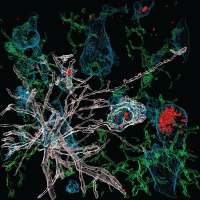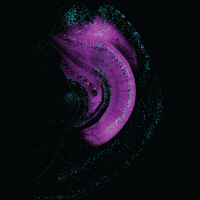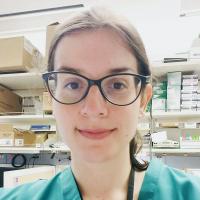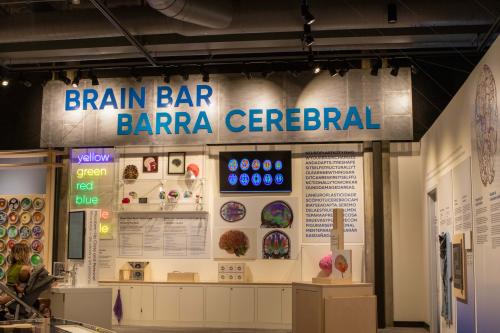UC Davis images featured in NeuroArt Exhibition at the SMUD Museum of Science and Curiosity
SACRAMENTO — On exhibit this summer at a museum near you: The Last Hope: Glial Cells Attacking SARS-Co-V2-Infected Neurons, a 3D reconstruction of cells that could be mistaken for modern art, and Pillars of Memory, an image of clusters of neurons in the hippocampus that looks like the Milky Way Galaxy.

Danielle Beckman, Ph.D./Morrison Lab
Visitors to the SMUD Museum of Science and Curiosity (MOSAC) are seeing firsthand what UC Davis neuroscientists and trainees know well.
Images of groundbreaking brain research can be visually stunning.
On May 16, 2024, a NeuroArt Exhibition at MOSAC opened that showcases 12 images from the UC Davis Center for Neuroscience (CNS) NeuroArt Contest. The contest, held each March in conjunction with Brain Awareness Week and NeuroFest, encourages neuroscientists and trainees across UC Davis to submit their most beautiful images that illustrate the wonder and complexity of the brain.

Jalina Graham, Ph.D./Wiltgen Lab
Center for Neuroscience
“We are absolutely thrilled to have CNS NeuroArt Contest finalists’ images displayed in the NeuroArt Exhibition at MOSAC,” said Kimberley McAllister, Ph.D. director of the Center for Neuroscience. “Each year, the contest brings together the UC Davis neuroscience community and allows us to share the awe-inspiring beauty of the nervous system with the public.”
The images in the NeuroArt Exhibition at MOSAC depict research from labs at UC Davis and UC Davis Health across three colleges, seven departments, and three centers, including the College of Engineering (Electrical and Computer Engineering); the College of Letters and Science (Psychology); the School of Medicine (Cell Biology and Human Anatomy; Neurology; Neurological Surgery; Ophthalmology and Vision Science; and Physiology and Membrane Biology); and the California National Primate Research Center (CNPRC); the Center for Neuroscience; the Center for Neuroengineering and Medicine.
“We are grateful for our partnership with MOSAC that allows us to reach a broad and diverse audience,” said McAllister. "Brain function and dysfunction affects everyone, and it's important to create opportunities to support curiosity and dialogue with the public and inspire the next generation of neuroscientists."
Using high resolution microscopy to better understand the neurological consequences of viral infections

Danielle Beckman, Ph.D., an associate project scientist in the Morrison Lab at the CNPRC, has entered the CNS NeuroArt Contest each year since the contest began in 2019 and has been a contest finalist eight times.
“The CNS NeuroArt contest is unique because NeuroFest attendees vote to select the best images, not other researchers, like most contests,” said Beckman. “It is a singular chance for us to get feedback from the public and also raise awareness about the importance of studying what is happening inside the brain.”
Beckman’s primary research focus is studying neuroinflammation and cortical organization. Over the past ten years, she has been developing her skills in high-resolution microscopy to better understand the neurological consequences of viral infections caused by Zika, HIV, and SARS-CoV-2.
“With one image, we can reach different audiences and explain complex events happening in the brain, like inflammation or cell death, and learn more about diseases like COVID-19 and Alzheimer's,” said Beckman.

Beckman chooses the colors for staining the images based on her primary objective. “Do we want to highlight how two different proteins colocalize in the same space? Or do we want to highlight a single specific process with a unique staining?” said Beckman. “I play a lot with the colors first and try different combinations, to observe if the message we want to relay to the viewer, is correctly achieved.”
Originally from Brazil, Beckman has been a researcher at UC Davis since 2017 and has four images in the NeuroArt Exhibition at MOSAC.
“Often, the images we produce in the lab are only seen by scientists in scientific manuscripts, so the fact that my images are included in the MOSAC exhibit and will be seen by the public makes me very happy,” said Beckman.
NeuroArt Exhibition complements new, permanent Health Connections, Conexiones de Salud gallery at MOSAC
The NeuroArt Exhibition at MOSAC is adjacent to the Health Connections, Conexiones de Salud gallery, a new, permanent exhibition presented by UC Davis Health that opened on June 7, 2024. Health Connections, Conexiones de Salud is the first bilingual exhibition at MOSAC, offered in English and Spanish. Visitors can explore what it means to be healthy and feel well through the many connections and layers of physical, social-emotional, and community aspects of health.

"The impactful images and informative captions in the NeuroArt Exhibition perfectly complement and amplify content featured in MOSAC's newest permanent gallery, Health Connections,” said Natalie Rhoades, manager of exhibits at MOSAC. “In this exhibition, visitors can marvel at the wonders and adaptability of the human brain through a variety of experiences designed to educate and inspire. The blend of NeuroArt images, fun, hands-on interactives, and scientific content in this gallery makes learning about health, both captivating and memorable."
Since opening in November 2021, MOSAC aims to increase access to STEM learning for all community members in the greater Sacramento area and serve as a dynamic regional hub that engages and inspires people of all ages to explore the wonders, possibilities, and responsibilities of science. The museum features upstairs and downstairs galleries with 100 interactive exhibits focused on space, astronomy, nature, water, energy, climate, and health.
The NeuroArt Exhibition at MOSAC is on display now through the end of 2024.
Media Resources
- Kimberly Cummings, marketing and communications specialist, UC Davis Center for Neuroscience
- kpcummings@ucdavis.edu
